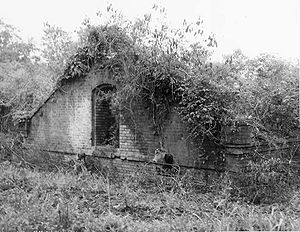| Siege of Fort St. Philip | |||||||
|---|---|---|---|---|---|---|---|
| Part of battle of New Orleans and War of 1812 | |||||||
 Fort St. Philip, overgrown in the mid 20th century | |||||||
| |||||||
| Belligerents | |||||||
| United Kingdom | United States | ||||||
| Commanders and leaders | |||||||
| Hugh Pigot | Walter H. Overton | ||||||
| Strength | |||||||
|
1 sloop-of-war 1 brig-of-war 1 schooner 2 bomb vessels[1][2] 2 bumboats[3] |
406 35 artillery pieces 1 gunboat | ||||||
| Casualties and losses | |||||||
| None[4] |
2 killed 7 wounded[5] | ||||||


The siege of Fort St. Philip was a ten day long distance bombardment of exploding bomb shells - by two Royal Navy bomb vessels, mounting a total of four mortars - against the American garrison of Fort St. Philip. The fort was unable to retaliate at the start, as the bomb vessels were out or the range of its solid shot cannon, and its mortar did not have ammunition. This was remedied by supply boats, whereby the fort counter-attacked the bomb vessels with its mortar on January 17, and the British duly withdrew.[7] This riverine engagement took place during the concluding hostilities of the War of 1812.
- ^ a b Letter from Cochrane to the Admiralty dated January 18, reproduced in "No. 16991". The London Gazette. 9 March 1815. pp. 449–451. stating 'I have not yet received any official report from the Captain of the Nymphe, which ship with the [other] vessels [Herald, Aetna, Volcano, Thistle, Pigmy] were sent into the Mississippi to create a diversion in that quarter.'
- ^ James (1818), p. 387 'Of the six vessels ordered up the Mississippi to bombard Fort-St. Philip, the Herald, two bomb vessels, and Thistle and Pigmy only could ascend the river.'
- ^ "Letter from Major Overton to Major General Jackson dated January 19th, 1815". Niles's Weekly Register. Vol. 8. 1815. pp. 58–59.
Early in the day of the 8th instant, I was advised of their approach, and on the 9th at a quarter past 10am hove in sight two bomb-vessels, one sloop, one brig and one schooner... and at half past twelve they advanced two barges
- ^ Fraser & Carr-Laughton (1930), p. 296.
- ^ "A list of the killed and wounded". Niles's Weekly Register. Vol. 8. 1815. p. 59.
- ^ a b Lossing, Benson (1868). The Pictorial Field-Book of the War of 1812. Harper & Brothers, Publishers.
- ^ Roosevelt (1900), p. 237.
